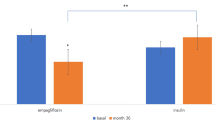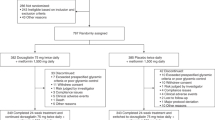Summary
The effects of troglitazone, a novel thiazolidinedione, in non-insulin-dependent diabetic (NIDDM) patients were studied in a double-blind, parallel-group, placebo-controlled, dose-ranging trial. A total of 330 patients (63% male), mean age 57 years (range 39–72), with two fasting capillary blood glucose values ≥ 7 and ≤ 15 mmol/l (within 2.5 mmol/l of each other) were randomised to treatment with placebo or troglitazone at doses of 200, 400, 600 or 800 mg once daily, or 200 or 400 mg twice daily, for 12 weeks. Prior to the study, treatment had been with diet alone (38% patients) or with oral hypoglycaemic agents which were stopped 3–4 weeks before study treatment started. During treatment, HbA1c tended to rise in patients taking placebo (7.2–8.0%), but remained unchanged with all doses of troglitazone. After 12 weeks of treatment, HbA1c was significantly lower in the troglitazone-treated (mean 7.0–7.4%) compared to the placebo-treated (8.0%) patients (p=0.055 to <0.001), as was fasting serum glucose concentration (troglitazone, 9.3–11.0 mmol/l vs placebo, 12.9 mmol/l, p<0.001). All doses of troglitazone were equally effective. Troglitazone also lowered fasting plasma insulin concentration, by 12–26% compared to placebo (p=0.074 to <0.001). Insulin sensitivity assessed by homeostasis model assessment (HOMA) was greater after 12 weeks of treatment in troglitazone-treated patients (troglitazone, 34.3–42.8% vs placebo, 29.9%, p<0.05). In addition, serum triglyceride and non-esterified fatty acid concentrations were significantly lower and HDL cholesterol higher at troglitazone doses of 600 and 800 mg/day. LDL cholesterol increased at 400 and 600 mg doses only (from 4.3 and 3.9 mmol/l at baseline to 4.8 and 4.5 mmol/l, respectively at 12 weeks, p<0.05), but not at doses of 800 mg once daily or 400 mg twice daily. LDL/HDL ratio did not change during treatment. All doses were well tolerated; incidence of adverse events in troglitazone-treated patients was no higher than in those treated with placebo. However, a tendency to reduced neutrophil counts was observed in patients taking the highest doses of troglitazone. We conclude that troglitazone is effective and well-tolerated and shows potential as a new therapeutic agent for the treatment of NIDDM.
Similar content being viewed by others
Abbreviations
- NIDDM:
-
Non-insulin-dependent diabetes mellitus
- HDL:
-
high density lipoprotein
- LDL:
-
low density lipoprotein
- NEFA:
-
non-esterified fatty acids
- HOMA:
-
homeostasis model assessment
References
De Fronzo RA, Bonadonna RC, Ferrannini E (1992) Pathogenesis of NIDDM: a balanced overview. Diabetes Care 15: 318–368
Turner RC, Matthews DR, Holman RR, Peto J (1982) Relative contributions of insulin deficiency and insulin resistance in maturity-onset diabetes. Lancet 1: 596–598
Yki-Jarvinen H (1994) Pathogenesis of non-insulin-dependent diabetes mellitus. Lancet 343: 91–95
WHO Study Group (1994) Prevention of diabetes mellitus. WHO Technical Report Series 844. World Health Organisation, Geneva, pp 3–7
Martin BC, Warram JH, Krowlewski AS, Bergman RN, Soeldner JS, Kahn CR (1992) Role of glucose and insulin resistance in development of type 2 diabetes mellitus: results of a 25 year follow-up study. Lancet 340: 925–929
DeFronzo RA, Ferrannini E (1991) Insulin resistance: a multifaceted syndrome responsible for NIDDM, obesity, hypertension, dyslipidaemia and atherosclerotic cardiovascular disease. Diabetes Care 14: 173–194
Eriksson KF, LindgÄrde F (1991) Prevention of type 2 (non-insulin-dependent) diabetes mellitus by diet and physical exercise. The 6-year Malmö feasibility study. Diabetologia 34: 891–898
Page RCL, Harnden KE, Cook JTE, Turner RC (1992) Can life-styles of subjects with impaired glucose tolerance be changed? A feasibility study. Diabet Med 9: 562–566
Fujiwara T, Yoshioka S, Yoshioka T, Ushiyama I, Horikoshi H (1988) Characterisation of a new oral antidiabetic agent CS-045: studies in KK and ob/ob mice and Zucker fatty rats. Diabetes 37: 1549–1558
Hargrove DM, Kreutter DK, Gibbs EM, Stevenson RW (1990) Mechanism of action of thiazolidinedione antidiabetic agents. In: Shaffir E (ed) Frontiers in diabetes research, Vol 3, 1st edn. Smith-Gordon, New York, pp 313–319
Kellerer M, Kroder G, Tippmer S et al. (1994) Troglitazone prevents glucose-induced insulin resistance of insulin receptor in rat-1 fibroblasts. Diabetes 43: 447–453
Kuzuya T, Iwamoto Y, Kosaka K et al. (1991) A pilot clinical trial of a new oral hypoglycaemic agent CS-045 in patients with non-insulin dependent diabetes mellitus. Diabetes Res Clin Pract 11: 147–154
Suter SL, Nolan JJ, Wallace P, Gumbiner B, Olefsky JY (1992) Metabolic effects of a new oral hypoglycaemic agent, CS-045 in NIDDM subjects. Diabetes Care 15: 193–203
Mimura K, Umeda F, Hiramatsu S et al. (1994) Effects of a new oral hypoglycaemic agent (CS-045) on metabolic abnormalities and insulin resistance in type 2 diabetes. Diabet Med 11: 685–691
Schnek AG, Schroeder WA (1961) The relationship between the minor components of whole normal adult haemoglobin as isolated by chromatography and starch block electrophoresis. J Am Chem Soc 83: 1472–1476
Soeldner JS, Slone D (1965) Critical variables in the radioimmunoassay of serum insulin using the double antibody technique. Diabetes 14: 771–779
Heding LG (1975) Radioimmunological determination of human C-peptide in serum. Diabetologia 11: 541–548
Friedewald WT, Levy RI, Friedrickson DS (1972) Estimation of concentrations of low density lipoprotein cholesterol in plasma, without the use of ultracentrifugation. Clin Chem 18: 499–502
Matthews DR, Hosker JP, Rudenski AS, Naylor BA, Treacher DF, Turner RC (1985) Homeostasis model assessment: insulin resistance and Β-cell function from fasting plasma glucose and insulin concentrations in man. Diabetologia 28: 412–419
Fleiss JL (1986) The design and analysis of clinical experiments. Wiley, New York, pp 186–207
Williams G (1994) Management of non-insulin-dependent diabetes mellitus. Lancet 343: 95–100
Gerich JE (1989) Oral hypoglycaemic agents. N Engl J Med 321: 1231–1245
Kosaka K, Kuzuya T, Akanuma Y, Hagura R (1980) Increase in insulin response after treatment of overt maturity-onset diabetes is independent of mode of treatment. Diabetologia 18: 23–28
Randle PJ, Kerbey A, Espinal J (1988) Mechanisms decreasing glucose oxidation in diabetes and starvation: role of lipid fuels and hormones. Diabetes Metabol Rev 4: 623–638
Reaven GM (1995) The fourth musketeer — from Alexandre Dumas to Claude Bernard. Diabetologia 38: 3–13
Lehman JM, Moore LB, Smith-Oliver TA et al. (1995) An antidiabetic thiazolidine dione is a high affinity ligand for peroxisome proliferator-activated receptor gamma (PPAR gamma). J Biol Chem 270(22):12953–12956
Kumar S, Durrington PN, Bhatnagar D, Laing I (1994) Suppression of non-esterified fatty acids to treat type A insulin resistance syndrome. Lancet 343: 1073–1074
Nolan JJ, Ludvik B, Beerdsen P, Joyce M, Olefsky J (1994) Improvement in glucose tolerance and insulin resistance in obese subjects treated with troglitazone. N Engl J Med 331: 1188–1193
Yoshioka T, Aizawa Y, Fujita T et al. (1991) Studies on hindered phenols and analogues. V. Synthesis, identification and anti-diabetic activity of the glucoronide of CS-045. Chem Pharma Bull 39: 2124–2125
Ogihara T, Rakugi H, Ikegami H, Mikami H, Masuo K (1995) Enhancement of insulin sensitivity by troglitazone lowers blood pressure in diabetic hypertensives. Am J Hypertens 8: 316–320
Hermann LS, Schersten B, Bitzen P et al. (1994) Therapeutic comparison of metformin and sulphonylurea, alone and in various combinations. Diabetes Care 17: 1100–1109
Hoffmann J, Spengler M (1994) Efficacy of 24-week monotherapy with acarbose, glibenclamide or placebo in NIDDM patients. Diabetes Care 17: 561–566
UK Prospective Diabetes Study Group (1995) United Kingdom Prospective Diabetes Study Group (UKPDS) 13: Relative efficacy of randomly allocated diet, sulphonylurea, insulin, or metformin in patients with newly diagnosed non-insulin dependent diabetes followed for three years. BMJ 310: 83–88
Author information
Authors and Affiliations
Consortia
Additional information
An Erratum for this chapter can be found at http://dx.doi.org/10.1007/BF02658520
An erratum to this article is available at http://dx.doi.org/10.1007/BF02658520.
Rights and permissions
About this article
Cite this article
Kumar, S., Boulton, A.J.M., Beck-Nielsen, H. et al. Troglitazone, an insulin action enhancer, improves metabolic control in NIDDM patients. Diabetologia 39, 701–709 (1996). https://doi.org/10.1007/BF00418542
Received:
Revised:
Published:
Issue Date:
DOI: https://doi.org/10.1007/BF00418542




